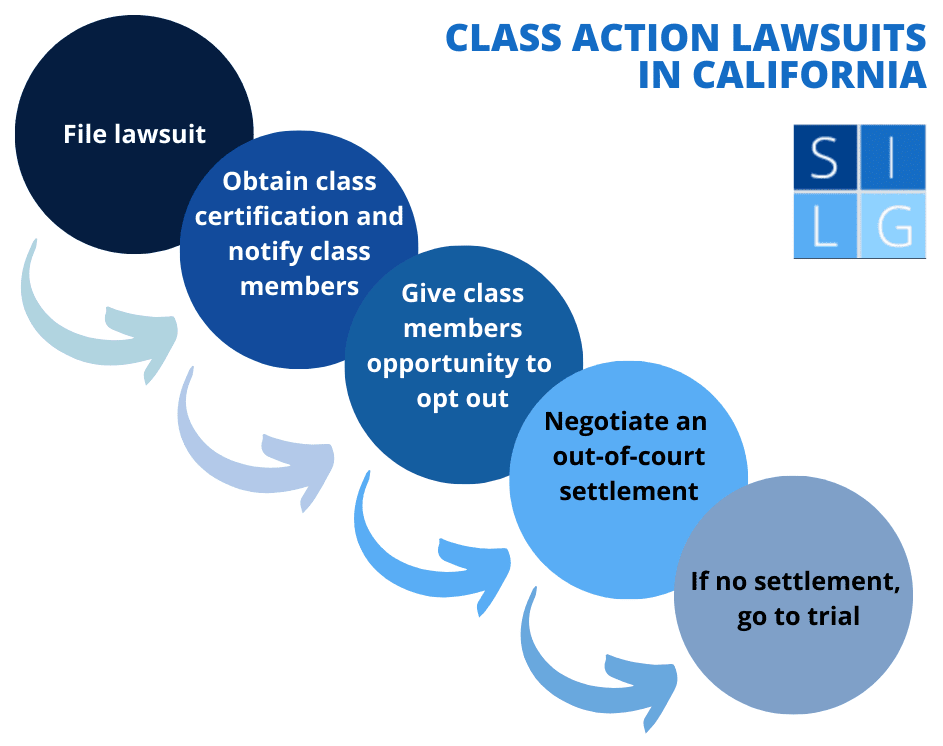
In California, class action lawsuits are a procedural tool allowing multiple people to file a lawsuit jointly when they all suffered the same type of harm at the hands of the same defendant. Named plaintiffs bring legal claims for the entire class, and other impacted people can join as class members.
Class actions are often brought against companies that:
Requirements to form a class action
Courts “certify” proposed class actions only when they meet these four thresholds:
Once a class action is formed, any ruling applies to all individuals fitting the class definition.
Benefits of class actions
Class actions achieve multiple public policy goals:
However, participating in a class action may require you to relinquish rights to sue independently.

A class action in California is a lawsuit that resolves a common issue of liability and/or damages affecting a large group of people. California Code of Civil Procedure § 382 provides:
“[W]hen the question is one of a common or general interest, of many persons, or when the parties are numerous, and it is impracticable to bring them all before the court, one or more may sue or defend for the benefit of all.”
Class actions are beneficial for cases where each class member is seeking a relatively small amount of money (like after being overcharged on a cable bill or other utility bill or being victims of a scam). Bringing an individual lawsuit would not be worth the expense, but bringing a class action would.

Similar injury victims with similar grievances may be able to band together in a collective action against the same business or person who harmed them.
You can initiate a class action in California. The first step is to file a lawsuit and move for certification.
The court then decides whether the proposed new class action claim meets the requirements for certification. At this point, the judge does not consider the underlying merits of the case. The judge only determines whether the claims should be tried under CCP 382. 1
To get a certification in California, you must establish that there is “an ascertainable class” and a “well-defined community of interest among [] members.” 2
“Community of interest” is determined by three factors:
You must also establish that resolving the claims in this type of lawsuit would “provide substantial benefits” to both the courts and the litigants. 3 This involves showing that this type of lawsuit is superior to alternative methods of resolving the dispute(s), including individual litigation. 4
Once the class is certified, the case moves forward as a lawsuit.
The court will notify potential members of the case by mailing them legal notice of the claim. The notice will explain what the class action case is about and the rights of each member.
If the class action litigation is eventually resolved in your favor (either by trial or settlement) the court will notify members how to make a claim for relief. In such a case, the defendant will usually be ordered to pay your fees and costs – including:
You usually have the right to “opt out” of class actions or proposed settlements in California. The opt-out procedure will be explained in the legal notice sent by the court.
By opting out, you retain the right to file an individual lawsuit. If you do nothing, you will be bound by any settlement or decision in the lawsuit.
Only if everyone in the class suffered identical damages. Usually there are some class members who sustained mild injuries and others who endured major losses. So once a class action finally settles, the money should be divided among the class members in proportion to your individual losses.
Both class actions and multi-district litigations (MDLs) involve groups of plaintiffs with similar injuries joining a common lawsuit. Though with MDLs, cases remain individual and separate rather than merging into one class.
This way, MDLs merely coordinate pre-trial proceedings across cases for increased efficiency while allowing each case to have a different outcome. This is in contrast to class actions, where members are bound together throughout with uniform settlements or verdicts applying equally to everyone who does not opt out of the class.
Another difference is that class actions automatically include anyone who meets the class definition, and members are given the option to opt out. With MDLs, plaintiffs need to affirmatively join the MDL through court filings.
For more in-depth information, refer to these scholarly articles: